Religion plays a
very important role in Thai life. Religion is considered an essential pillar of
society, it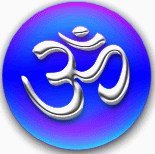 is not only the major moral
is not only the major moral 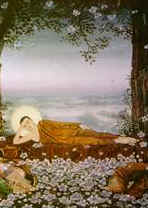 force of Thai family and community but has also
contributed to the molding of freedom loving, individualistic, and tolerant
people for many centuries.
force of Thai family and community but has also
contributed to the molding of freedom loving, individualistic, and tolerant
people for many centuries.
Theravada or Hinayana Buddhism is the national religion of Thailand but there is total religious freedom and all major religions can be found in practice. There is absolute freedom of
religion - Islam, Christianity, Hinduism and other faiths are practiced and protected by the constitution.
Buddhism is the faith of 95 percent of the population, 4 percent are Muslims,
0.5 percent and Christians, and the remainder Hindus, Sikhs and other religion.
Despite the fact that Buddhism is the faith of majority, both the king and the
government uphold and support all the religions accepted by the people. Amidst
rich diversity of beliefs, people of Thailand have always lived together in
peace and harmony.
faith of 95 percent of the population, 4 percent are Muslims,
0.5 percent and Christians, and the remainder Hindus, Sikhs and other religion.
Despite the fact that Buddhism is the faith of majority, both the king and the
government uphold and support all the religions accepted by the people. Amidst
rich diversity of beliefs, people of Thailand have always lived together in
peace and harmony.
Buddhism
Buddhism first appeared in Thailand during the 3rd century B.C. in the area of the present day provincial capital Nakhon Pathom. Once established, it proved such a durable and pervasive force that some ethnic groups who migrated into that area during the Dvaravati period readily adopted it as their state religion.
Briefly, Buddhism teaches that one's life does not begin with birth and end with death but is a link in a chain of lives, each
conditioned by volitional acts (karma) committed in previous existences. The concept of karma, the law of cause and effect,
suggests that selfishness and craving result in suffering. Conversely, compassion and love bring happiness and well-being.
Therefore, only by eliminating desire can one find peace of mind. The ideal Buddhist aspiration is to attain perfection through
Nirvana
(Nibbhana), an indescribable, immutable state unconditioned by desire, suffering, or further rebirth, in which a person
simply is, yet is completely at on with his surroundings.
After its introduction into Thailand, Buddhism gained wide acceptance because its emphasis on tolerance and individual initiative complemented the Thai's cherished sense of inner freedom. Fundamentally, Buddhism is an empirical way of life. Free of dogma, it is a flexible moral, ethical, and philosophical framework within which people find room to fashion their own salvation.
Sukhothai's King Ramkhamhaeng (1275-1317 A.D.) established Theravada Buddhism as Thailand's dominant religion. It
reached its height under the reign of King Ramkhamhaeng's grandson, king Li Thai (1347-1368 A.D.), when about 30 volumes of the Buddhist scriptures were studied and rewritten by the king into one volume, the
Tribhumikatha, a treatise on Buddhist cosmology and the three planes of existence-Sensuous, Corporeal, and Incorporeal. Not only was this the first Buddhist treatise
by a Thai, but it was this the first known Thai Buddhist
literary work. The Tribhumikatha's impact on religious arts such as mural paintings can be seen today in many monasteries in various provinces.
Through the centuries Buddhism has been the main driving force in Thai cultural development. Much of classical Thai art,
particularly architecture, sculpture, painting, and early literature, is really Buddhist art.
Then and even now, Buddhism colors everyday Thai life.
Although Buddhism became the primary and state religion, Thais always subscribed to the ideal of religious freedom. Thai
constitutions have stipulated that Thai king must be Buddhists, but monarchs are invariably entitles "Upholder of All Religions". Consequently, the government, through the Religious Affairs
Department, annually allocates funds to finance religious education
and to construct, maintain, and restore monasteries, mosques, and churches.
The Temple &
the village
The majority of Thailand's 27,000 Buddhist temples are in the countryside.
Usually located on the village outskirts, walled compound enclosing a cluster of simple, steeply sloping, multi-roofed buildings.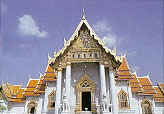 Although the
temple's prime function is to aid aspirants in their search for Nirvana, it has traditionally served as the village hotel, a village news, employment
and information agency, a school, hospital, dispensary or community center, and a recreation
center, place of safe deposit and refuge for the mentally disturbed and the ages.
Although the
temple's prime function is to aid aspirants in their search for Nirvana, it has traditionally served as the village hotel, a village news, employment
and information agency, a school, hospital, dispensary or community center, and a recreation
center, place of safe deposit and refuge for the mentally disturbed and the ages.
In large towns, the temple offers hostel accommodation for students from the outlying villages. In others, orphans and children from poor families are admitted for
free board, lodging and basic education and, occasionally, juvenile delinquents are sent to live in monasteries to be reformed under the benevolent influence of elderly
monks.
As in medieval Europe, most early Thai scholars were clerics whose major monastic activity was to teach the unlettered. Behind the quiet facade of monastic life,
many village boys learned the rudiments of reading and writing Thai and Pali, simple arithmetic and the Buddhist precepts. Education was primarily concerned with
ethical and religious instruction. Because most early Thai literature concerned religion, literacy allowed greater participation in religious life.
Although the Department (later Ministry) of Education was founded in 1887, monasteries remained
centers of basic education until nationwide primary education became compulsory in 1921. In many remote areas today, monks conduct daily classed for village children.
Besides being teachers, many of the orange-robed, tonsured Buddhist monks are experts in the use of herbal medicines. They distribute Buddhist amulets and
perform exorcisms in a role that survives from the antique animist period. Amulets and exorcism represent an accretion of
pre-Buddhist animistic beliefs on the main body of Buddhist thought. The amulets are tiny Buddha
images worn around the neck to ensure good fortune, provide protection and enhance wealth. Although
almost universally revered in Thailand, Buddha amulets are nowhere mentioned in Buddhist scriptures.
Another vital village 'monastic service' is counseling. Abbots and senior monks are often requested to arbitrate local disputes. Their monastic prestige is considered
sufficient guarantee that equitable resolutions will be forwarded and accepted. Before
ordination, many senior monks have led active secular lives raising their own
families and farming. Thus, familiar with temporal problems and able to empathize, they are uniquely qualified to fashion and maintain social harmony, employing their
considerable moral authority, if necessary, to gently admonish miscreants before minor disputes escalate.
Monk Hood
Buddhist monks have always been accorded great respect for renouncing worldly pleasures and seriously undertaking study of the Buddha's teaching to attain 'perfect manhood'.
Thai Buddhist monk hood differs from that of other religions in
several ways. In Thailand's tropical climate, the monk's austere life is never unduly severe. Though a monk is celibate and may not be touched by a woman, even his mother, his life is not totally cloistered. Meditating monks excepted, daily contact with the laity is commonplace, mostly during morning collections of alms beyond the monastery precincts, and at various ceremonies and festivals.
Monks abide by strict monastic discipline, observing 227 rules governing their behavior. The breaking of the four principal rules - theft, homicide of inciting another
to suicide, sexual relations or claiming magical powers - will result in immediate expulsion from the monastic order.
Unlike other monastic regimens, Buddhist monk hood does not demand manual labor of its monks. Physical work is recognized as having value in allaying
destructive thoughts and desires. However, the Buddhist monk, preferring annihilation of temptation and craving to suppress them, elects to seek and destroy them
through meditation.
Freedom of discussion is allowed. A Buddhist monk may question and part of the Buddha's teaching - He may study parts of the doctrine he feels important to his
advancement and choose his own time to meditate. Except for the three months of the annual Rains Retreat, he is free to travel, a legacy from Buddhism's earliest
days when the Buddha and his disciples led itinerant life.
A monk may leave the monk hood any time he wishes. The Thai ordination is a public notice of a man's intention to follow the Buddha's teaching. He is not obliged
to remain a monk for life, nor does any stigma attach should he decide to return to secular life.
Although Buddhism flourished during the Ayutthayan period, historically little is known of Ayutthayan Buddhism because of the near total destruction of the
Kingdom's records. The year following 1767 found Buddhism in disarray. The situation improved when the first Chakri king, Rama I, re-established religious as well
as social order.
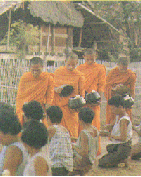 Today, Theravada Buddhism is the professed religion of over 90% of the Thai people, and profoundly influences everyday life. It finds expression in the Thais'
tolerance and kindness towards their fellow men, regardless of race, creed or nationality. It is visibly strengthened by the close daily contact the laity enjoys with
Buddhist monks during morning food collections and casual meetings. People acquire 'merit' by donating food to the monks; by building and renovating temples; by
constructing and renovating temples; by constructing hospitals; and by showing kindness and compassion to all living creatures. Such merit
favorably affects one's present as well as future incarnations.
Today, Theravada Buddhism is the professed religion of over 90% of the Thai people, and profoundly influences everyday life. It finds expression in the Thais'
tolerance and kindness towards their fellow men, regardless of race, creed or nationality. It is visibly strengthened by the close daily contact the laity enjoys with
Buddhist monks during morning food collections and casual meetings. People acquire 'merit' by donating food to the monks; by building and renovating temples; by
constructing and renovating temples; by constructing hospitals; and by showing kindness and compassion to all living creatures. Such merit
favorably affects one's present as well as future incarnations.
All major Buddhist holy days are national holidays. These include Magha Puja (commemorating the miraculous occasion when 1250 disciples gathered
spontaneously to hear the Buddha preach); Visakha Puja (commemorating the Buddha's birth, enlightenment and final passing away); and Khoa Phansa (the
commencement of the annual three-month Rains Retreat when all monks stay inside their monasteries to study and meditate).
Buddhist monks chant auspicious stanzas blessing the openings of new businesses. They officiate at housewarmings.
Brides and grooms make meritorious offerings of food on their wedding days and are blessed and sprinkled with holy water. Monks also chant prayers
during nightly rites preceding cremations.
One fundamental reason for the Thais generous support of the Sangha (the Buddhist monastic order) is that there are few Buddhist families in which at least
one member has not studied the Buddha's teaching within monastic surroundings. Not uncommonly, a man, after discharging his worldly duties and family obligations,
will spend his remaining years as a Buddhist monk.
It has likewise long been a Thai custom for Buddhist males over twenty to be temporarily ordained as Buddhist monks, generally during the annual Rains Retreat.
Government offices, certain sections of the armed forces and larger private companies make temporary ordinations easier by granting their employees three months'
leave with full salary.
Temporary ordination, ranging from five days to three months, is not the exclusive privilege of any one class. Everyone from a farmer's son to royalty may take this
unique change for self-improvement.
Mahayana Buddhism
The Mahayana (The Great Vehicle) is more of an umbrella body for a great variety of schools, from the Tantra school (the secret teaching of Yoga) well represented in Tibet and Nepal to the Pure Land sect, whose essential teaching is that salvation can be attained only through absolute trust in the saving power of Amitabha, longing to be reborn in his paradise through his grace, which are found in China, Korea and Japan. Ch'an and Zen Buddhism, of China and Japan, are meditation schools.
It is generally accepted, that what we know today as the Mahayana arose from the Mahasanghikas sect who were the earliest
affiliate, and the forerunners of the Mahayana. They took up the cause of their new sect with zeal and enthusiasm and in a
few decades grew remarkably in power and popularity. They adapted the existing monastic rules and thus
revolutionized the
Buddhist Order of Monks. Moreover, they made alterations in the arrangements and interpretation of the Sutra
(discourses) and
the Vinaya (rules) texts. And they rejected certain portions of the canon, which had been accepted in the First Council.
According to it, the Buddhas are lokottara (supramundane) and are connected only externally with the worldly life. This conception of the Buddha contributed much to the growth of the Mahayana philosophy. The ideal of the Mahayana school is that of the Bodhisattva, a person who delays his or her own enlightenment in order to compassionately assist all other beings and ultimately attains to the highest Bodhi.
Mahayana Buddhists are found primarily among Thailand's ethnic Chinese and Vietnamese. There are some 21 major Chinese monasteries and 25 meeting halls. Mahayana monks are easily distinguished from Theravada monks by their orange jackets and trousers. Strict vegetarians, they eat only food prepared by their monasteries and are not required to be celibate. Their daily routine is concerned with elaborate rituals and with preparation for the funerals and burials over which they preside.
Vietnamese monks are found in 13 major monasteries. Though dressed like the Chinese monks, they are not subject to special dietary regulations and make daily morning food collections.
History of Lord Buddha
Siddhartha (Buddha) was born around 563 B.C. in the town of Kapilavastu (located in today's Nepal). Siddhartha's parents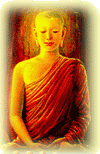 were King
Shuddhodana and Queen Maya, who ruled the Sakyas. His history is a miraculous one... One night, Queen Maya dreamed that an elephant with six tusks, carrying a lotus flower in its trunk, touched her right side. At that moment her son was conceived.
Brahmins (learned men) came and interpreted the dream. The child would be either the greatest king in the world or the greatest ascetic (a holy man who practices self-denial). The future child would be named Siddhartha, which means "he whose aim is accomplished."
were King
Shuddhodana and Queen Maya, who ruled the Sakyas. His history is a miraculous one... One night, Queen Maya dreamed that an elephant with six tusks, carrying a lotus flower in its trunk, touched her right side. At that moment her son was conceived.
Brahmins (learned men) came and interpreted the dream. The child would be either the greatest king in the world or the greatest ascetic (a holy man who practices self-denial). The future child would be named Siddhartha, which means "he whose aim is accomplished."
Later when Queen Maya was going to her father's home to prepare for the birth, she stepped off her chariot in the Lumbini Gardens and held the branch of a sal tree to rest. In that instant, Siddhartha emerged from her right side without any help. The infant walked seven steps each in four directions of the compass, and lotus flowers sprouted from where his foot touched the earth. Then the infant said, "No further births have I to endure, for this is my last body. Now shall I destroy and pluck out by the roots the sorrow that is caused by birth and death." Seven days later Queen Maya died.
Mahaprajapati, Maya's sister, looked after Siddhartha. King Shuddhodana shielded Siddhartha from all kinds of suffering and hardship. When Siddhartha was about 20, he married
Yasodhara, daughter of one of the King's ministers, and one year later they had a child named Rahula (meaning "fetter" or "impediment").
At age 29, Siddhartha asked his charioteer, Channa, to take him out of the city two times without the consent of the king. During these two trips, Siddhartha saw "Four Sights" that changed his life. On the first trip, he saw old age, sickness, and death. The second trip, he saw a wandering holy man, an ascetic, with no possessions. Siddhartha started questioning the holy man, who had a shaved head, wore only a ragged yellow robe, and carried a walking-staff. The man said, "I am... terrified by birth and death and therefore have adopted a homeless life to win salvation... I search for the most blessed state in which suffering, old age, and death are unknown." That night, Siddhartha silently kissed his sleeping wife and son, and ordered Channa to drive him out to the forest. At the edge of the forest, Siddhartha took off his jeweled sword, and cut off his hair and beard. He then took off all his princely garments and put on a yellow robe of a holy man. He then ordered Channa to take his possessions back to his father.
Siddhartha then wandered through northeastern India, sought out holy men, and learned about Samsara (reincarnation), Karma, and
Moksha (freedom from the cycle of life and death). Attracted to the ideas of Moksha, Siddhartha settled on the bank of Nairanjana River, and adopted a life of
extreme self-denial and penances, meditating constantly. After six years of eating and drinking only enough to stay alive, his body was emaciated, and he was very weak. Five other holy men joined him, hoping to learn from his example.
One day, Siddhartha realized that his years of penance only weakened his body, and he could not continue to meditate properly. When he stepped into the river to bathe, he was too weak to get out, and the trees lowered their branches to help him. In that instant, a milk-maid named Nandabala came and offered a bowl of milk and rice, which Siddhartha accepted. The five holy men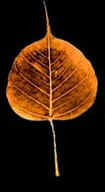 left Siddhartha after witnessing this. Refreshed by the meal, Siddhartha sat down under a fig tree (often
referred to as the Bo tree, or Tree of Enlightenment) and resolved to find out an answer to life and suffering. While meditating, Mara (an evil god) sent his three sons and daughters to tempt Siddhartha with thirst, lust, discontent, and distractions of pleasure. Siddhartha,
un-swayed, entered a deep meditation, and recalled all his previous rebirths, gained knowledge of the cycle of births and deaths, and with certainty, cast off the ignorance and passion of his ego which bound him to the world. Thereupon, Siddhartha had attained
enlightenment and became the Buddha (enlightened one). His own desire and suffering were over and, as the Buddha, he experienced Nirvana... "There is a sphere which is neither earth, nor water, nor fire, nor air...which is neither this world nor the other world, neither sun nor moon. I deny that it is coming or going, enduring, death or birth. It is only the end of suffering." Instead of casting off his body and his existence, however, Buddha made a great act of self-sacrifice. He turned back, determined to share his
enlightenment with others so that all living souls could end the cycles of their own rebirth and suffering.
left Siddhartha after witnessing this. Refreshed by the meal, Siddhartha sat down under a fig tree (often
referred to as the Bo tree, or Tree of Enlightenment) and resolved to find out an answer to life and suffering. While meditating, Mara (an evil god) sent his three sons and daughters to tempt Siddhartha with thirst, lust, discontent, and distractions of pleasure. Siddhartha,
un-swayed, entered a deep meditation, and recalled all his previous rebirths, gained knowledge of the cycle of births and deaths, and with certainty, cast off the ignorance and passion of his ego which bound him to the world. Thereupon, Siddhartha had attained
enlightenment and became the Buddha (enlightened one). His own desire and suffering were over and, as the Buddha, he experienced Nirvana... "There is a sphere which is neither earth, nor water, nor fire, nor air...which is neither this world nor the other world, neither sun nor moon. I deny that it is coming or going, enduring, death or birth. It is only the end of suffering." Instead of casting off his body and his existence, however, Buddha made a great act of self-sacrifice. He turned back, determined to share his
enlightenment with others so that all living souls could end the cycles of their own rebirth and suffering.
Buddha went to the city of Sarnath and found the previous five holy men that deserted him earlier at a deer park. When they saw
Buddha this time, they realized that he had risen to a higher state of holiness. The Buddha began teaching them what he had learned. He drew a circle in the ground with rice grains, representing the wheel of life that went on for existence after existence. This preaching was called his Deer Park Sermon, or "Setting in Motion the Wheel of Doctrine." Siddhartha revealed that he had become the Buddha, and described the pleasure that he had first known as a prince, and the life of severe asceticism that he had practiced.
Neither of these was the true path to Nirvana. The true path was the Middle Way, which keeps aloof from both extremes.
"To satisfy the necessities of life is not evil," the Buddha said. "To keep the body in good health is a duty, for otherwise we shall not be able to trim the lamp of wisdom and keep our mind strong and clear." Buddha then taught them the Dharma, which consisted of the Four Noble Truths and the Eightfold Path. The five holy men and others soon joined Buddha, accompanying him everywhere. As more joined, Buddha organized the Sangha, a community of
Bhikkus (dedicated monks and later nuns). The Sangha preserved the Dharma, and allowed
Bhikkus to concentrate on the goal of Nirvana. On raining seasons they would settle in Viharas (resting places in cave dwellings).
Upasaka, followers who believed in Buddha's teachings, but could not follow the
strict rule of the Sangha, were taught to follow the Five Precepts. Buddha returned to his birthplace in Kapilavastu, and his father was mortified to see his son begging for food. Buddha kissed his father's foot and said, "You belong to a noble line of kings. But I belong to the lineage of
Buddhas, and thousands of those have lived on alms." King Shuddhadana then remembered the Brahmin's prophesy and reconciled with his son. Buddha's wife, son, and cousin (Ananda) later joined the Sangha.
When Buddha was about eighty, a blacksmith named Cuanda gave him a meal that caused him to become ill. Buddha forced
himself to travel to Kushinagar, and laid down on his right side to rest in a grove of shala trees. As a crowd of followers gathered, the trees sprouted blossoms and showered them on Buddha. Buddha told Ananda, "I am old and my journey is near its end. My body is like a worn-out cart held together only by the help of leather straps." Three times, Buddha asked the people if they had any questions, but they all remained silent. Finally Buddha said, "Everything that has been created is subject to decay and death. Everything is transitory. Work out your own salvation with diligence. After passing through several states of meditation, the Buddha died, reaching Parinirvana (the cessation of perception and sensation).
For more information on Buddhism, click here.
Muslims
Muslims comprise Thailand's largest religious minority and are concentrated mainly in the
southern most provinces of Narathiwat,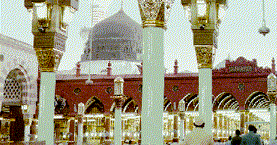 Pattani, Yala, and Satun. Islam is said to have been introduced to the Malay Peninsula by Arab traders and adventures during the 13th century. Most Thai Muslims are Malay descent, reflecting the common cultural heritage Thailand's southernmost provinces share with Malaysia.
Pattani, Yala, and Satun. Islam is said to have been introduced to the Malay Peninsula by Arab traders and adventures during the 13th century. Most Thai Muslims are Malay descent, reflecting the common cultural heritage Thailand's southernmost provinces share with Malaysia.
Ninety-nine percent Sunni and one percent Shi'ite Thai Muslims enjoy inspirational and
financial support from His Majesty the King, who provided money for translating the Koran into Thai. Each year the King or his representative also presides during celebration commemorating the Prophet Muhammad's birthday. Moreover, His Majesty appoints a respected Muslim religious leader as Chularajamontri, or State Counselor for all Islamic affairs. The government also provides funds for building and
renovating mosques.
In some southern provinces where the Muslim population is substantial, government-employed Muslims are allowed to leave for important Muslim festivals and allowed to work half-days on Friday, the Muslim holy day. In such provinces family and
inheritance cases are judged according to Koranic with a Muslim religious judge, or
"kadi", sitting on the bench. In addition, one four months' leave with full salary is also granted to allow an employee to make the
Hajj, the pilgrimage to Mecca.
There are approximately 2,000 mosques in Thailand, about 100 of which are in Bangkok. Some 200 Muslim schools offer
secular as well as religious instruction. All in all, Thailand's Muslims enjoy full state support and are free to teach and practice their religion according to their own tenets.
For more information on Islam and Muslims, click here.
Christianity
Christianity was introduced to Thailand by European missionaries in the 16th and 17th centuries. These early Catholic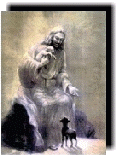 missionaries were later joined by Protestants of the Presbyterian, Baptist, and Seventh-day Adventist sects. Their converts mainly came from ethnic minorities such as the immigrant Chinese. Despite the small number of Thai converts, Christians have made several major contributions in the fields of health and education.
missionaries were later joined by Protestants of the Presbyterian, Baptist, and Seventh-day Adventist sects. Their converts mainly came from ethnic minorities such as the immigrant Chinese. Despite the small number of Thai converts, Christians have made several major contributions in the fields of health and education.
Thailand's first printing press was introduced by Christians, and King Mongkut (Rama IV) learned English and Latin from
Christians missionaries. Though King Mongkut reportedly told one of his missionary friends "What you teach us to do is
admirable, but what you teach us to believe is foolish", during his
monk hood before ascending the throne, he nonetheless allowed
Christian missionaries to give lectures, even in his own
monastery. Christians introduced surgery, made the first smallpox
vaccinations, trained the first doctors in Western medicine, and wrote the first Thai-English dictionaries.
Thailand's Christian population is estimated at 0.5% of the
total population.
For more information on Christianity, click here.
Hinduism
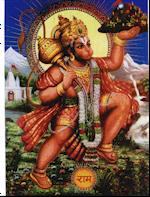 The
approximately 20,000 Indians residing in Thailand are almost equally divided
between Hindus and Sikhs. The Hindu community is mostly concentrated in Bangkok,
where it worships at four main Hindu temples. There are also several Brahman
shrines at which Hindus and Buddhists alike worship. The Hindus operate their
own school where the curriculum is based on the Thai education system, though in
addition to Thai it teaches Hindi, Sanskrit,
and English.
The
approximately 20,000 Indians residing in Thailand are almost equally divided
between Hindus and Sikhs. The Hindu community is mostly concentrated in Bangkok,
where it worships at four main Hindu temples. There are also several Brahman
shrines at which Hindus and Buddhists alike worship. The Hindus operate their
own school where the curriculum is based on the Thai education system, though in
addition to Thai it teaches Hindi, Sanskrit,
and English.
For more information on Hinduism, click here.
Sikhism
 The
Sikhs, too, are concentrated mainly in Bangkok. Divided into two sects, they
worship at two different temples. Collectively, the Sikhs operate a free school
for poor children, regardless of caste, creed, or religion, and through several
charitable associations they support the aged and the sick.
The
Sikhs, too, are concentrated mainly in Bangkok. Divided into two sects, they
worship at two different temples. Collectively, the Sikhs operate a free school
for poor children, regardless of caste, creed, or religion, and through several
charitable associations they support the aged and the sick.
For more information on Sikhism, click here.
Copyright © 2000 - 2002 HelloSiam.com All rights reserved.